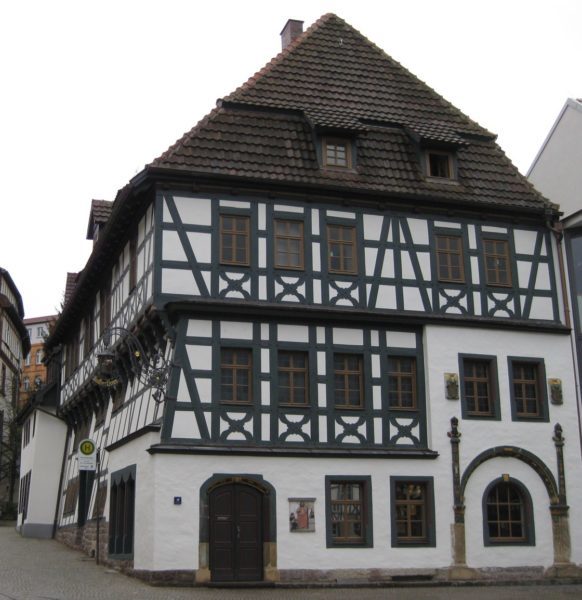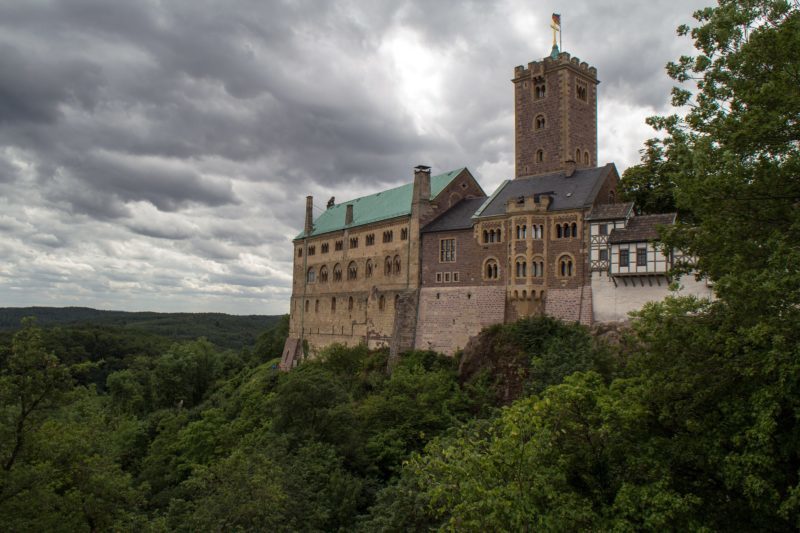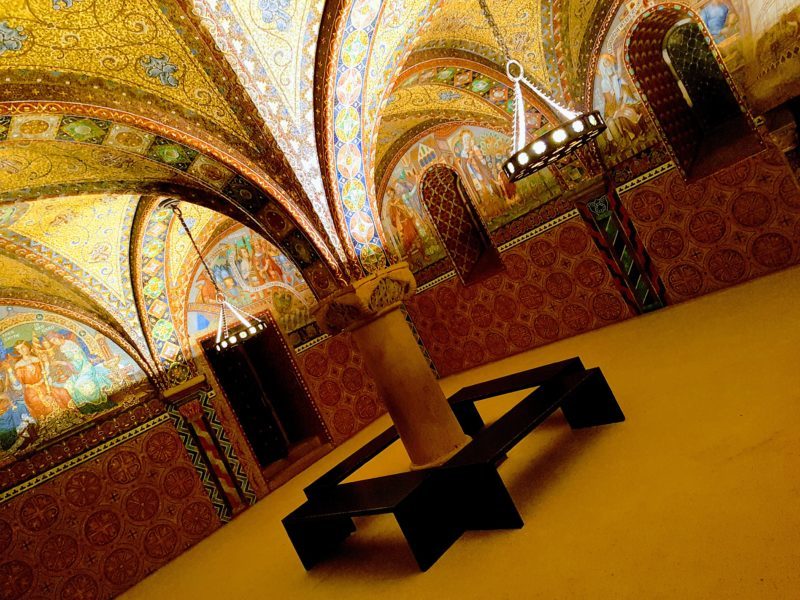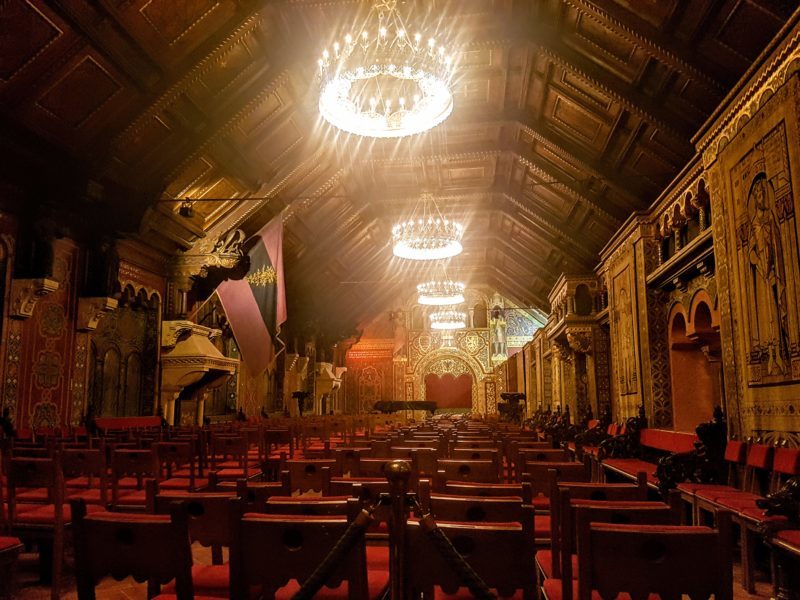Last updated: 25 June 2023
This is the fifth and final post in our five part series covering my recent travels through the Thuringia region of Germany. The first post was all about the town of Erfurt, capital of the Thuringia region. The second post explored the cultural elements of Germany’s oldest town, Arnstadt. The third post explored the grand Friedenstein Castle which is home to over 350 years of Gotha history. The fourth post covered all the reasons why Weimar can be considered the cultural heart of the region. This post will provide an overview of some of the scenic historical and cultural places to visit in Eisenach. Are you ready? Great, here we go!
Where is Eisenach?
Eisenach is located in the Thuringia region of Germany, about 50 km (31 mi) west of Erfurt, 200km (120mi) North East of Frankfurt.

Measuring 104 km² in size and with a population of 42,000, Eisenach is a relatively small town however it’s historical and cultural significance makes it a popular tourist destination.
Why Visit?
A visit to Eisenach is essential if you have any interest in history. From Martin Luther to Johann Sebastian Bach to incredible German castles (with one of the best concert halls I’ve ever seen!), Eisenach is wonderful.
I have to admit that before visiting province I wouldn’t have been able to point out where the Thuringia region was on a map. After exploring each of the towns and learning about their individual (and collective) history that I began to realise just how important they all were.
A visit to Eisenach gives you so many wonderful opportunities to connect with history, experience musical culture, and visit epic castles.
The Martin Luther Connection
This is an important year for Germany’s Thuringia region because of its close connection to Martin Luther, The Reformer.

2017 marks 500 years since the beginning of the Protestant Reformation, an event which not only changed the face of Christianity across Germany and Europe but its impact can still be felt across the globe today.
Lutherhaus
Martin Luther once said about Eisenach that “No city knows me better” and during your visit you’ll learn why; Luther spent many of his most important school years in Eisenach where he attended St George’s Latin School from 1498 to 1501.

One of the first places I’d recommend visiting is Lutherhaus, an interactive museum which provides hours of detailed information about The Reformer and the years of the Protestant Reformation.
The museum is housed in one of the oldest buildings in the entire Thuringia region and was where Martin Luther lived with the influential Cotta and Schalbes family during his school days.

The Lutherhaus is a European cultural heritage site and has been operating as a museum since 1956. Renovation works were undertaken in the lead up to the 500 year anniversary.
The Essentials
Prices
- Adults €6
- Concessions €4
Opening Hours
- Apr to Oct. Mon-Sun. 10am – 5pm
- Nov to Mar. Tue-Sun. 10am – 5pm
Bachhaus
Arguably, Eisenach’s most famous son was the musical genius; Johann Sebastian Bach.
During my travels through Thuringia, there was one name which kept popping up during my visits; Johann Sebastian Bach. It turned out that Bach was not only born in Thuringia but visited and lived in many of the Thuringia towns during his lifetime.
Bach was born in Eisenach on 21 March 1685 into a grand musical family. It was from his family – father, brother, uncles, and cousins, that Bach was taught various elements of music theory and instruments, including the organ.
As I discovered during my visit to Arnstadt, Bach’s first paying job was as the Church organist at the New Church (now named the Bach Church, no prizes for guessing why). After a tempestuous time in Arnstadt, Bach moved to Muhlhausen for several months before returning to Weimar.

It was in Weimar where Bach lived for 9 years composing various pieces of music, including parts of his influential work; The Well-Tempered Clavier. Weimar honours their famous resident through the below bust, located near the Anna Amalia Library
During a visit to Eisenach you can learn about the life and times of Johann Sebastian Bach at the Bachhaus, a 600m² museum boasting 250 original artefacts.

The museum was first opened in 1907 by the New Bach Society and today is considered one of the largest musical museums in Germany. Make sure you time your visit for the hourly 20 min concert which is comprised of house organs, clavichord, Silbermann spinet and a harpsichord.
The Essentials
Prices
- Adults €9
- Concessions €5
Opening Hours
- 10am – 6pm daily
Wartburg Castle
If there’s one place you should make time for during a visit to Eisenach it has to be Wartburg Castle. Situated atop a 410 metre (1350 feet) cliff face, there is no wondering why the castle was built here, it dominates the landscape and provides sweeping views over Eisenach.

Wartburg Castle was founded over 1000 years ago by Louis the Springer, Count of Schauenburg who laid the foundations in 1067. The castle has been listed as a UNESCO world heritage site since 1999.
Wartburg Castle has undergone many renovations and additions over the centuries to it’s current appearance. It’s interesting to note that the castle itself wasn’t built for fortification reasons as it was constructed during a peaceful time in Germany but rather as a demonstration of prestige and wealth. If you take a tour through the interior of the castle then you will see 200 various columns, many of them original masterpieces that have a unique sculpture sitting atop the columns.

St Elizabeth of Hungary
During your visit to Wartburg Castle you will learn about St Elisabeth of Hungary, as her life is tied closely to the castle and its inhabitants. Elizabeth was a Hungarian princess who was brought to Wartburg Castle at the age of four where she was raised to become the consort of Landgrave Ludwig IV of Thuringia.

At age 14, Elizabeth married Ludwig IV and they appeared to have a relatively happy marriage (I guess as happy as a 14 year old could be getting married). The marriage lasted only six years when Ludwig died from fever on his way to join the Sixth Crusade. Elizabeth spent the next four years continuing her charitable work and devotion to helping the poor. Unfortunately, the final years of Elizabeth’s short life were less than happy as she was manipulated by those around her and died at age 24. Elizabeth was canonised and became Saint Elisabeth less than five years after her death.

Martin Luther & The Translation of the Bible
Did you know that one of Martin Luther’s greatest achievements was translating the New Testament bible from its original Greek into German? This was a groundbreaking event in the field of literature in Germany because the newly translated (and published) bible became the foundation of the German written language as we know it today.

During your visit to Wartburg Castle, you can actually the original room where Martin Luther spent a mere 11 weeks translating the New Testament bible. The furniture in the room, the desk and stove, might not be original but at least you can see what his room may have looked like during his time spent at Wartburg.
Speaking of the stove in the room, you may notice a large section of some brickwork missing behind it. That’s an interesting story…
The Throwing of the Inkwell
There’s a story that during one of many nights that Martin Luther was at his desk completing the translation of the bible that the devil appeared and Luther defended himself by throwing his inkwell at him. The ink splashed across the wall and stained it.

Fast forward to the next century when Protestant pilgrims arrived at Wartburg Castle to pay tribute to Luther The Reformer. The pilgrims began to take parts of the ink-stained wall as a type of souvenir. It wasn’t long until the ink-stained wall began to disappear, the soldiers in the castle began to throw more ink on the walls to encourage repeat visitors (guess something’s don’t change, everyone loves a tourist)
This cycle continued for some time until the missing brickwork became very noticeable at which point no further ink was splashed across the wall, leaving exposed brickwork, which you will see during your visit. Sadly, you won’t be able to take a piece of the wall with you.
The Concert Hall
One of the highlights of my visit to Wartburg Castle was the Concert Hall which actually left me speechless. Perhaps it was because I didn’t expect it, I hadn’t heard of it, and I certainly wasn’t prepared for how spectacular it was.

We were told by our guide that the theme of the concert hall was about how the strength of Christianity defeated the ancient pagans. As we sat there listening to classical music, I felt transported to another time. It was honestly amazing.
Can you believe that this hall is actually used everyday for a variety of functions, including high school graduations!
The Essentials
Prices – Guided Tour / Museum
- Adults €9 / €5
- Disabled €7 / €4
Wartburg Castle is open 365 days a year
April – October
- Guided tours: 8.30am to 5pm
- Guided tour in English: daily at 1.30pm
- Castle grounds: open until 8pm
November – March
- Guided tours: 9am to 3.30pm
- Guided tour in English: daily at 1.30pm
- Castle grounds: open until 5pm
Final Thoughts
The only downside of my visit to Eisenach was that I didn’t have enough time to explore more. As a fan of history, I loved being able to follow in the footsteps of Martin Luther, Johann Sebastian Bach, and walk through the halls of a 1000 year old castle! If you’re planning a visit to Germany then make sure that you add the Thuringia region to your itinerary because there is just so much to explore.
Have you visited Eisenach? If so, what did you think?
Let us know in the comments below
Disclaimer
Our travel through the Thuringia region was in partnership with the Thuringia tourism board. As usual, all opinions expressed remain our own.
